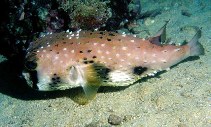| Family: |
Diodontidae (Porcupinefishes (burrfishes)) |
| Max. size: |
30 cm SL (male/unsexed) |
| Environment: |
demersal; marine; depth range - 100 m |
| Distribution: |
Indo-Pacific. |
| Diagnosis: |
Dorsal spines (total): 0-0; Dorsal soft rays (total): 10-12; Anal spines: 0-0; Anal soft rays: 10-11. Pelagic specimens with small spots covering body; benthic specimens with 4 dark bars on flanks and a blotch on each pectoral and dorsal fin bases; fins unspotted (Ref. 4423).
Description: Characterized by light brown color dorsally and white ventrally; black lips; blackish bar below eye; short spines, most on head and belly two-rooted and erectile, spines on sides and back three-rooted and fixed; caudal peduncle with a pair of prominent spines dorsally (Ref. 90102). |
| Biology: |
Continental shelves to 100 m (Ref. 9680). Also found on sand-rubble bottoms (Ref. 90102). Adults benthic, juveniles pelagic (Ref. 30573). Presumably feeds on hard-shelled invertebrates (Ref. 9680). Not usually marketed (Ref. 9680). Not a common species (Ref. 9680). |
| IUCN Red List Status: |
Least Concern (LC); Date assessed: 15 August 2023 Ref. (130435)
|
| Threat to humans: |
harmless |
Source and more info: www.fishbase.org. For personal, classroom, and other internal use only. Not for publication.
